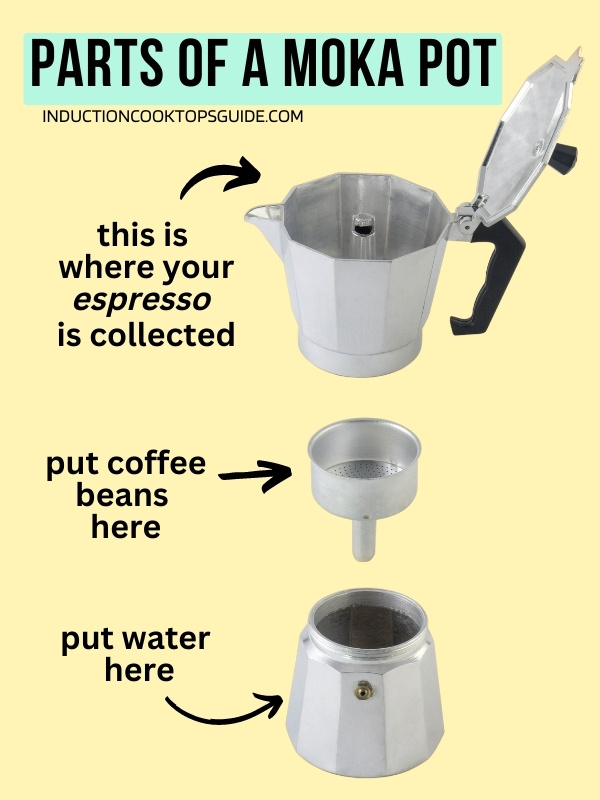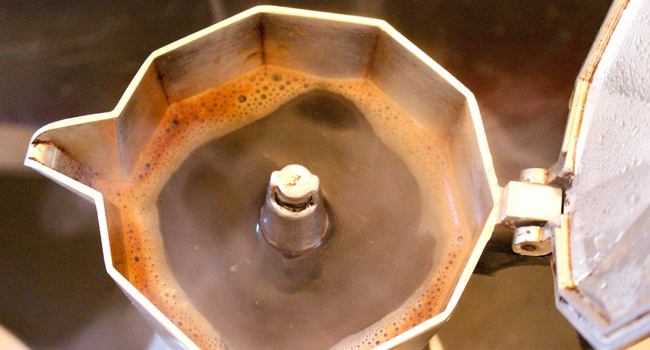Moka pots are making their way again into the kitchens of coffee lovers. They make superb coffee like your café baristas or espresso machines without breaking the bank.
However, unlike espresso machines, you must first check their compatibility with your cooktop— especially if you have an induction.
By now, you know that induction is picky with its cookware. So, can you use a Moka pot on an induction hob?
Let’s see and find out!
Can you use a Moka coffee pot on an induction hob?
To many, coffee serves as the much-needed push to get things started. Instead of ordering Starbucks forever or waiting for your office to acquire an espresso machine, you need to get yourself a Moka pot!
A Moka pot is also called a stove-top espresso or Moka express. It’s a two-piece kettle designed by Alfonso Bialetti in the 1930s.
The goal (and this has since been realized) was to bring café-like coffee to Italian homes back then. Now, the world partakes in that tradition too.
A Moka pot has three components: the bottom chamber (the base), the funnel filter, and the upper chamber where coffee is collected. Designs may vary, but these three remain crucial.

First, you put water in the bottom chamber up to the valve. Position the funnel filter inside the chamber and fill the filter with ground coffee.
You have to put it on the stove and let the water boil.
The pressure from the boiling process pushes the water and coffee mixture to the upper chamber, where it is collected until all the water turns to steam.
Do you hear that sputtering? Aye, that is the sound of a morning ritual gone right. Behold! Your coffee is ready!
Pro tip no. 1: Use normal temperature, mineral bottled water. “Hard” water, as in tap water, deposits limescale inside the chamber when heated. Some prefer hot water instead of ambient temperature. Never use cold water since it can lead to a metallic and bitter taste.
Pro tip no. 2: The type of coffee matters. Moka pots use coarse coffee grounds compared to espresso machines, so be mindful of what you buy!
Now that you get the gist and a few tips about Moka pots, there’s one more essential factor to check before you head out and grab the magic kettle: cooktop compatibility.
Since you’re here, you may be particularly interested in how it works on your induction—or if it works at all.
To complete your full immersion in the Moka pot life, understanding the basics of your induction is essential.
You don’t want to ruin your coffee grounds, your Moka pot, or worse, your induction trying in vain!
A crash course in induction science
Induction cooktops do not use a flame to provide direct heat. The source of heat comes from the cookware itself.
An alternating current running on a power coil produces a fluctuating magnetic field. This changing magnetic field affects the iron atoms in the cookware and makes them vibrate in response. The vibration releases energy in the form of heat.
It’s vital to emphasize iron here. Technically, all ferromagnetic materials react to the fluctuating magnetic field similarly. However, iron is the most common ferromagnetic material in home utensils and cookware.
For example, raw and enameled cast iron and magnetic stainless steel have enough iron to respond to induction cooktops readily.
Aluminum, copper, glass, and ceramic don’t so cookware made solely of any of those will not work without any aid.
So if your Moka pot falls into the non-ferromagnetic category, it will not inherently work with your induction.
Moreover, do not merely assume it works when they advertise that it is induction-ready!
Take as an example: The Coffee Gator Moka pot found on Amazon markets itself suitable with both gas and induction. And if you glance at the material composition, you might nod in agreement since you see stainless steel listed along with aluminum.
However, with further reading, you’d realize that the Moka pot is aluminum while the accompanying cups are stainless steel. Yikes!
But don’t despair if you have Moka pots that are not induction-suitable. Nowadays, finding a go-between for everything isn’t too hard.

How to use Moka pot on induction stove
The standard Moka pot has an aluminum composition. Naturally, it will not work on induction. The new ones which do work are magnetic stainless steel.
What makes aluminum desirable?
It has 16 times higher thermal conductivity than stainless steel. It’s able to heat fast and distribute it effectively. It’s more affordable and lightweight too.
But just because it came first doesn’t mean that should also be your endgame.
Stainless steel Moka pots look modern and are more durable. Although they will take more time to heat up, they can retain that heat better. They also work on all cooktops.
FYI: Not all stainless steel is the same. Some have less iron and are of thin quality; thus, the pots won’t heat evenly and may deform eventually.
If you want convenience over traditional options, go for brands of known high-quality stainless steel Moka pots or those which come with a magnetized base.
Before shopping, ensure that you get the dimensions of your induction zones. If you purchase a pot that’s way smaller in diameter than your burner zone, it might not be able to detect the pot, and nothing will happen!
If you already have an aluminum Moka pot and do not want to switch, that’s alright too!
The Moka pot induction adapter comes to the rescue!
You heard that right! An adapter, or heat diffuser, is a round metal plate often made of magnetic stainless steel. The heat from the adapter transfers directly to the non-ferromagnetic Moka pot.
Again, you must ensure high quality when choosing your adapter. You want it to be thick and magnetic enough to make heat transmission as efficient as possible.
When looking for a reliable option, the Bialetti stainless steel heat diffuser is suitable for coffee makers (1-9 cups capacity) and small pots.
Whether using your induction-compatible pot or an adapter, set the induction at the start on medium heat to boil the water. Once the coffee appears in the upper chamber, lower the temperature and let it percolate until finished.
Is Bialetti Moka pot induction compatible?
Bialetti is to Moka pots what Le Creuset is to dutch ovens. They come almost synonymously due to the long history which ties the specific brand to the product.
Indeed, their fame does not come unfounded. Bialetti’s quest to evolve with technology produced the first induction-compatible Moka pots.
You can choose from two options: the full stainless steel and the aluminum-stainless steel combination.
The former includes the line Kitty, Musa, and Venus. They differ in design, but all have stainless steel exteriors and silicone handles to prevent scalding. However, note that the 2-cup versions of Kitty and Venus and the 1-cup and 2-cup Musa coffee makers are not induction-suitable.
The latter category is highly distinctive. It has an octagonal aluminum upper body and a bilayer lower chamber consisting of exterior stainless steel and interior aluminum, ensuring compatibility with induction while maintaining performance. Rossa, Nerra, and Brika are Bialetti’s lines with this bilayer technology.
It’s classic and chic at the same time!
Among the Bialetti products, the Rossa Moka pots garner excellent reviews with their striking red color and quality.
Best Moka pot for induction hob
Aside from Bialetti, there are other brands whose Moka pots work with induction. With varying designs and capacities, these Moka pots will not fail to impress your caffeine-devoted heart.
One important note before we jump: you must utilize a Moka pot at its full capacity. If you are the type to have friends over often, you may opt for Moka pots of higher capacity, e.g., a 12-cup Moka pot can make 775 mL or 25 oz of coffee.
Now, onto the Moka pots hoard!
1. Cuisinox Roma Coffee Maker
Pros: Made of quality 18/10 stainless steel, this coffee maker also comes with an optional reducer disk, allowing you to make less coffee when you opt to. It’s available in 4-, 6-, and 10-cup versions.
Cons: Heaviness might damage the glass surface of induction. It’s also hard to clean.
2. Bialetti Elegance Venus Induction 6 Cup
Pros: It’s made of stainless steel and has an ergonomic and easy-to-clean design. It comes in 4-, 6-, and 10-cup capacities. And like the traditional Bialetti Moka pot, this also makes a fantastic coffee flavor.
Cons: Some report durability issues and improperly sealed silicone gaskets.
3. Geesta Glass Top Moka Pot
Pros: The upper glass chamber allows you to gauge visually if your coffee is ready. It’s available in 4-,6-, and 9-cup capacities. Aesthetically different from the traditional.
Cons: Some reported leaking issues, and you need it to cool down fully before washing it.
4. Leopold Vienna Moka Pot
Pros: Adorably compact and classic design makes it perfect for solo connoisseurs. It’s easy to clean and comes in three gorgeous colors.
Cons: It’s more expensive than other options.
5. Bodum Chambord Moka Pot
Pros: If you want a break from the classic designs, the maker of the famous Chambord French Press pulls through with a rounder, simplistic take on your Moka pot.
Cons: It may have durability issues, especially with the handle. It only comes in 3- and 6-cup versions.
Can you make Turkish coffee on an induction hob?
It will not come as a surprise, but the first thing you must acquire to fully experience the rich and thick Turkish coffee is… a Turkish coffee pot!
Also called a cezve (Jez-VEY) or ibrik in Arabic, the Turkish coffee pot is originally made of copper and uses extra finely-ground coffee. The main goal is to create a thick foam by not boiling or stirring it while heating it.
Since the traditional pot uses a non-ferromagnetic material, it may be discouraging to use it with your induction. However, like your Moka pots, you can use a heat diffuser to facilitate the heating process instead.
Most available cezve in the market also does not meet the induction criteria, albeit stainless steel.
Try the Ilsa Omnia 2-cup Turkish coffee pot as a starter. It has a 60mm diameter which you need to consider when dealing with the efficiency of your burner zones.
Meanwhile, you can look for options at import stores like the Metalac brand found in Balkan/Serbian stores.
Some give up on the thought of an induction-friendly cezve and recommend using a tall and thin saucepan instead.
Whatever your choice is, do remember that composition and thickness of the pot matter if you want heat efficiency from your induction.

Leave a Reply